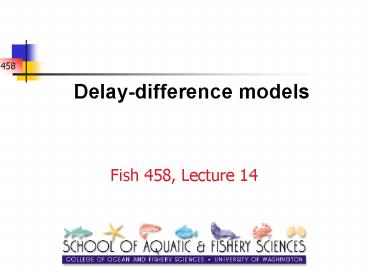Delay-difference models - PowerPoint PPT Presentation
1 / 19
Title:
Delay-difference models
Description:
Title: Presentation Template Author: Paul Boult Last modified by: pun009 Created Date: 6/3/1998 12:23:14 AM Document presentation format: On-screen Show – PowerPoint PPT presentation
Number of Views:25
Avg rating:3.0/5.0
Title: Delay-difference models
1
Delay-difference models
- Fish 458, Lecture 14
2
Delay-difference models
- Provide an intermediate option between
age-aggregated and full age-structured models. - Are based on some key simplifying assumptions
that allow age-structured dynamics to be
simplified to a single equation involving total
biomass or total numbers only. - Do not require much information.
- Are useful when a realistic model is needed
that doesnt require substantial data / computer
memory.
3
A delay difference model for the total number of
animals in a population
Note s is natural survival if there is no
exploitation or survival from all causes of
mortality but then it is necessary to assume
that the exploitable part of the population is
the same as the mature part.
4
Some typical recruitment functions
5
Moving from numbers to biomass-I
- The previous delay-difference model ignored
growth because it dealt only with numbers. - We will now extend the framework to include
- Growth
- Time-dependent mortality (due to, for example,
harvesting).
6
Moving from numbers to biomass-II
- The simplest way to model changes in (mature)
biomass is to assume that recruitment is in
units of biomass and to take account of growth. - g is the proportional change in mass from one
year to the next, i.e. - st is the survival rate during year t from
all causes. - This model is the lagged recruitment, survival
and growth (LRSG) model. Lets derive it from
first principles.
7
Deriving the LRSG model - I
- is the biomass of animals aged L and older at
the start of year t - The survival rate during year t is the product of
survival from natural causes and from
exploitation (note that vulnerability is assumed
to be 1 for all animals older than age L and zero
below this age) - Dont forget the standard age-structured dynamics
equation
8
Deriving the LRSG Model-II
9
Extending the biomass-based delay-difference
model-I
- One of the fundamental assumptions of the LRSG
model is its growth model. - However, for ggt1 this model implies that mass
increases exponentially with age. In contrast,
mass-at-age for most species exhibits asymptotic
behavior.
10
Starting with an Asymptotic Growth Curve
- The von Bertalanffy growth curve is probably the
most common used in fisheries. Assuming that
mass-at-age (rather than length-at-age) follows a
von Bertalanffy growth curve, mass-at-age is
governed by the recursive equation - where ? is the Brody growth coefficient.
11
Deriving the full Deriso-Schnute model
12
More on the Deriso-Schnute model
Survival of biomass
Growth
Notes
Recruitment
- mass-at-recruitment
The original Deriso version corresponds to
The virgin (no fishing) equilibrium is given by
13
Extensions
- Allowing for partial recruitment.
- Harvesting can be continuous or occur
instantaneously in the middle of the year. - A variety of functions are available to predict
recruitment. - Delay-difference models based on size can also be
derived.
14
Overview-I
- Provides an elegant link between the
age-aggregated (e.g. logistic) models and more
complicated (age-, size- and stage-structured)
models. - Rests on some key simplifying assumptions
- Mass-at-age follows a von Bertlanffy growth
curve. - Recruitment and maturity occur at the same time.
- Vulnerability is independent of age above the
age-at-maturity. - Natural mortality is independent of age above the
age-at-maturity.
15
Overview-II
- Some of the assumptions are highly restrictive,
particularly - Vulnerability independent of age
- Age-at-recruitment equals age-at-maturity
- Only one fishery.
- Not used much today because we have the computing
resources to implement full age-structured models.
16
Comparison of Dynamic Schaefer, age-structured
and Deriso-Schnute models (Cape hake)
- Age-structured model
- M assumed to be 0.4yr-1.
- Mass-at-age age-specific.
- Logistic vulnerability - inflection point at age
3. - Maturity at age 4.
- Deriso-Schnute model
- M assumed to be 0.4yr-1.
- Estimate ? from the mass-at-age data.
- Knife-edged vulnerability / maturity at age 3.
- Parameters B0, steepness (r and K), q and ?.
- Fitted to CPUE and survey data
- Stock assumed to be at B0 in 1917.
17
Model Selection
- The three models are not nested but the data and
likelihood functions are identical. - We can compare these models using AIC (and AICc)
18
Model Selection
Schafer model -LnL -95.00 Delay-difference
model -LnL -106.02 Age-structured model -LnL
-104.58
19
Readings
- Hilborn and Walters (1992), Chapter 9
- Deriso, R.B. (1980). Can. J. Fish. Aquat. Sci.
37 268-282. - Schnute, J. (1985). Can. J. Fish. Aquat. Sci. 42
414-429. - Schnute, J. (1987). Can. J. Fish. Aquat. Sci..
44 924-940. - Fournier, D.A., Doonan, I.J. (1987). Can. J.
Fish. Aquat. Sci. 44 422-437.































